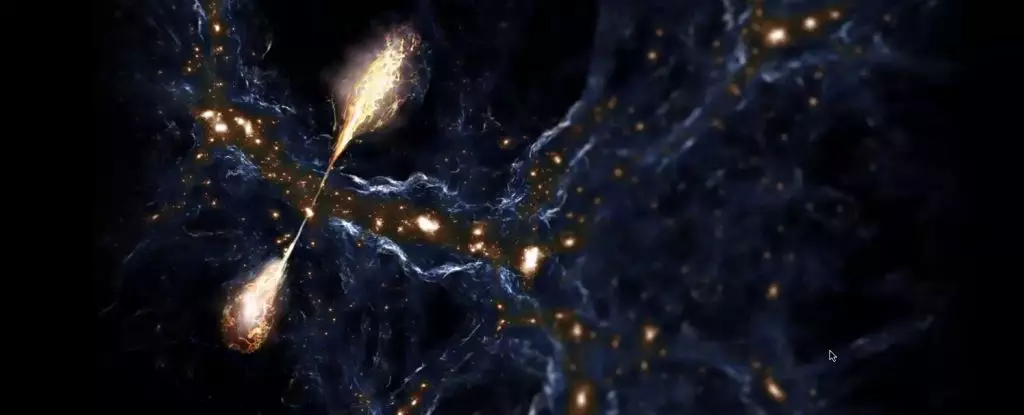Astronomy is a field teeming with wonders, and recent discoveries continue to stretch our comprehension of the cosmos. At the forefront of this expanding frontier is the revelation of a supermassive black hole entitled Porphyrion, a behemoth in both size and influence. This black hole is not merely a solitary object in space; it has produced colossal astrophysical jets that extend approximately 7 megaparsecs—equivalent to an astounding 23 million light-years—across the fabric of space-time. This finding introduces both excitement and intrigue, propelling scientists to deepen their understanding of cosmic structures and the role that black holes play within the larger Universe.
Porphyrion, named after the mythological king of giants, signifies far more than just another celestial body. Its immense size challenges previous limits set on cosmic phenomena. The implications of such a discovery extend to our understanding of the cosmic web, a vast network of filaments connecting galaxies throughout the universe. The revelation that a single black hole can create structures comparable to these immense cosmic formations encourages us to reconsider our assumptions about galactic evolution and interactions.
According to Martijn Oei from Leiden University, this connection poses a compelling idea: the intricacies of small-scale and large-scale cosmological structures are interwoven. The example provided is particularly striking. If we were to scale Porphyrion down to the size of an amoeba, its jets would correspond to an energy fountain capable of spouting across the entire Earth. This unusual analogy not only highlights the sheer power of black hole jets but also serves to remind us of the interconnectedness of cosmic events and the importance of studying black holes.
While the discovery of Porphyrion is awe-inspiring, it does not stand alone. Its existence follows closely behind the identification of Alcyoneus, another galaxy whose jets span an impressive 16 million light-years. Both instances suggest a commonality in the mechanism behind these colossal jets, prompting scientists to question the rarity of such events. Previous theories doubted that jets could achieve such magnitude, but recent findings suggest that the conditions for generating these extraordinary structures may be more frequent than previously thought.
Researchers have made some headway in understanding the mechanisms behind the formation of jets propelled by black holes. It is known that as a black hole consumes material, magnetic fields play a crucial role in channeling and accelerating the resulting plasma and radiation into space. Nonetheless, this now raises several questions: What accounts for the sustained feeding of the black hole over billions of years? How do these jets maintain their stability across such vast distances?
Oei and his team have pointed out crucial challenges regarding the longevity and stability of astronomical jets. Given that jets are believed to be inherently unstable, this raises a paradox in understanding how they could have remained cohesive over such extensive distances of time and space. The interaction of fundamental forces, as well as the complexity of magneto-hydrodynamics, could provide additional layers to this enigma, demanding a reevaluation of our current models.
The discovery of Porphyrion suggests that these giant jets may play a pivotal role in the architecture of the cosmic web. Notably, the length of Porphyrion’s jets is significantly commensurate with the void they occupy, reinforcing hypotheses that these jets may elevate temperature and influence magnetic structures within otherwise barren areas of space. Previous models depicting the cosmos as a static, unyielding web may need radical revision in light of this new data.
The relationship between supermassive black holes and their surrounding environments continues to become clearer, with the potential for further revelations about the early Universe. The assertion that an active, radiative black hole of the type seen in Porphyrion could have existed in greater numbers during cosmic history opens a wealth of possibilities. This could not only reshape our knowledge of the past but also influence future observational programs aimed at identifying giant jet systems across the Universe.
As scientists push the boundaries of our comprehension, the technologies to observe the cosmos are also rapidly advancing. Oei predicts that as observational tools improve, we may uncover a trove of galaxies harboring similar structures—possibly changing our perspective on the prevalence of such jets entirely. The future could very well reveal that the sky is dotted with gaping mouths of cosmic dragons, each feeding and carving out the cosmos in ways we have yet to fathom.
The journey into understanding Porphyrion, its creation, and its implications is only the beginning. As we stand on the brink of new discoveries, the cosmic tapestry is revealed as an intricate dance of creation and destruction, revealing the beautiful complexity of our universe. Through continued exploration and examination, we may soon determine not just the significance of gigantic jets, but also unveil the hidden symphony of forces that shape our reality.


Leave a Reply